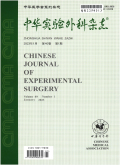脊髓损伤铜死亡关键基因二氢硫辛酰胺脱氢酶的生物信息学分析
Bioinformatics analysis of cuproptosis key gene dihydrolipoyl dehydrogenase in spinal cord injury
摘要目的:运用生物信息学分析铜死亡关键基因二氢硫辛酰胺脱氢酶(DLD)在脊髓损伤患者中的表达差异,并探讨其与脊髓损伤免疫微环境、相关信号通路之间的关系。方法:通过高通量基因表达数据库(GEO)获取脊髓损伤患者的相关数据集,采用R语言分析该数据集中对照组患者和脊髓损伤组患者铜死亡关键基因的表达差异;根据美国脊髓损伤协会(ASIA)分级,将脊髓损伤患者分为脊髓损伤轻度组患者和脊髓损伤重度组患者,采用R语言分析对照组患者和不同脊髓损伤分级患者中DLD的表达差异。采用免疫细胞浸润分析探究DLD与脊髓损伤患者不同类型免疫浸润细胞之间的相关性;采用STRING数据库筛选与DLD作用的相关基因,并进行基因集富集分析(GSEA)。结果:DLD和金属调节转录因子1(MTF1)在脊髓损伤组(1.51±0.12、1.83±0.14)中的表达明显高于对照组(1.24±0.11、1.47±0.13, t=8.58、9.12, P<0.05);脂酰转移酶1(LIPT1)、硫辛酰合成酶(LIAS)、谷氨酰胺酶(GLS)和铁氧还蛋白(FDX1)在脊髓损伤组(0.97±0.09、0.17±0.02、0.81±0.08、0.69±0.06)中的表达明显低于对照组(1.21±0.10、0.30±0.03、1.02±0.07、0.94±0.07, t=7.67、14.72、7.88、11.21, P<0.05)。脊髓损伤轻度组患者(1.44±0.12)的DLD表达水平明显高于对照组患者(1.24±0.11, t=6.83, P<0.05);脊髓损伤重度组患者(1.62±0.14)的DLD表达水平明显高于脊髓损伤轻度组患者(1.44±0.12, t=6.35, P<0.05)。相关性分析结果显示,DLD与M2巨噬细胞水平呈明显的正相关( R=0.36, P=7.5e-03);与CD8 +T细胞、初始CD4 +T细胞水平呈明显的负相关( R=-0.42, P<0.05; R=-0.40, P<0.05)。 结论:DLD在脊髓损伤患者中高表达,且与脊髓损伤的严重程度和免疫微环境密切相关。
更多相关知识
abstractsObjective:Bioinformatics was used to analyze the differential expression of dihydrolipoamide dehydrogenase (DLD), a key gene for cuproptosis, in patients with spinal cord injury, and to explore its relationship with the immune microenvironment and related signaling pathways.Methods:The high throughput gene expression omnibus (GEO) was used to obtain the relevant data set of spinal cord injury patients. R language was used to analyze the expression difference of key genes of copper death between the control group and the spinal cord injury group in this dataset. According to the American Spinal Injury Association (ASIA), the spinal cord injury group was divided into mild spinal cord injury group and severe spinal cord injury group. R-language was used to analyze the difference in DLD expression between the control group and patients with different spinal cord injury classification. Immunocell infiltration analysis was used to investigate the correlation between DLD and different types of immunoinfiltrating cells in patients with spinal cord injury. The genes associated with DLD were screened using STRING database, and gene set enrichment analysis (GSEA) was performed. Independent-sample t-test was used to compare measurement data between groups. Results:The expressions of DLD and MTF1 in spinal cord injury group (1.51±0.12, 1.83±0.14) were significantly higher than those in control group (1.24±0.11, 1.47±0.13, t=8.58, P<0.05, t=9.12, P<0.05). The expressions of LIPT1, LIAS, GLS and FDX1 in the spinal cord injury group (0.97±0.09, 0.17±0.02, 0.81±0.08, 0.69±0.06) were significantly lower than those in the control group (1.21±0.10, 0.30±0.03, 1.02±0.07, 0.94±0.07, t=7.67, P<0.05, t=14.72, P<0.05, t=7.88, P<0.05, t=11.21, P<0.05). The expression level of DLD in mild spinal cord injury group (1.44±0.12) was significantly higher than that in control group (1.24±0.11, t=6.83, P<0.05). The expression level of DLD in the severe spinal cord injury group (1.62±0.14) was significantly higher than that in the mild spinal cord injury group (1.44±0.12, t=6.35, P<0.05). Correlation analysis showed that DLD was positively correlated with M2 macrophage ( R=0.36, P=7.5e-03), and negatively correlated with CD8+ T cells and naive CD4+ T cell were negatively correlated ( R=-0.42, P<0.05 R=-0.40, P<0.05). The STRING analysis shows that, the 10 key interacting genes of DLD are DLAT, PDHB, PDHA1, PDHX, BCKDHA, BCKDHB, DLST, DBT, OGDH and AMT. The results of GO and KEGG analysis showed that DLD plays an important role mainly through tricarboxylic acid cycle, pyruvate metabolism, acetyl-CoA synthesis and metabolism, branched-chain amino acid degradation, and histone succinylation. Conclusion:DLD is highly expressed in patients with spinal cord injury, and is closely related to the severity of spinal cord injury and immune microenvironment. In-depth exploration of the functional proteins and signaling pathways related to DLD is of great significance for the study of the pathological mechanism and clinical treatment of spinal cord injury.
More相关知识
- 浏览6
- 被引0
- 下载0


相似文献
- 中文期刊
- 外文期刊
- 学位论文
- 会议论文



 换一批
换一批 换一批
换一批



